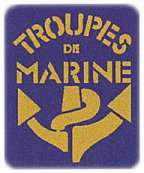Troupes de marine
| Troupes de la marine | |
|---|---|
|
Troupes de Marine logo | |
| Active | 1622–Present |
| Country |
|
| Branch | French Army |
| Type |
Infantry Artillery Airborne |
| Role | Marines |
| Motto(s) | Et au Nom de Dieu, vive la coloniale! ("And in the name of God, long live the Colonial") |
| Colors | Red and blue |
| Anniversaries | Battle of Bazeilles |
| Insignia | |
| Beret badge of the Troupes de Marine |
 |
| Abbreviation | TDM |
The Troupes de marine, formerly the Troupes coloniales, are an arm of the French Army with a tradition of service overseas. Despite their title they have long been a part of the Army and were renamed from their former colonial title in 1958. They are sometimes referred to as French marines in English-speaking media,[1][2] though they are not connected to either the French naval infantry (the Fusiliers Marins) or French naval special forces (the Commandos Marine).[3]
Soldiers of the troupes de marine are likely to spend much more of their service overseas, particularly in Africa, than other French soldiers. Their units include infantry (including light tank units and airborne units) and artillery.
The Troupes de marine were founded in 1622 (officially titled compagnies ordinaires de la mer) as land forces under the control of the navy, notably for operations in French Canada. The Troupes de marine were transferred to the army in 1900 and became the Troupes Coloniales (Colonial Troops). Their nickname la Coloniale or la Colo refers to this heritage.
At their height in 1940, the Troupes Coloniales consisted of nine divisions and several demi-brigades who manned machine gun emplacements on the Maginot Line. They were recruited both in France and overseas.
With France divesting itself of its colonies, the historic title of Troupes de marine was readopted on 4 May 1961. This was after a brief period from 1958 when all the Troupes Coloniales had been designated as Troupes d' Outre-Mer (Overseas Troops) . They became a major component in France's Forces d'Intervention.
History
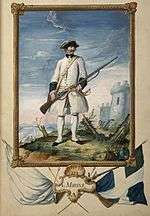
The Troupes de Marine originate from the compagnies ordinaires de la mer created in 1622 by Cardinal Richelieu. These were troops dedicated to naval combat. The French colonies were under the control of the Ministère de la Marine (analogous to the British Admiralty), so it used its marines for colonial defense as well.
Ancien Régime
Sea Companies and Marine Regiments (1622-1673)
The first Marine units were the Sea Companies (compagnies ordinaires de la mer), created by Cardinal Richelieu in his capacity of Grand Master of Navigation. These companies were merged into a single infantry regiment, dedicated to shipboard and overseas service. This first Marine unit was followed by several other regiments, all eventually transferred to the Army between 1640 and 1673.
- Régiment de la Marine, formed in 1627 from the Sea Companies. The regiment was transferred to the Army and later became the 11th Line Infantry Regiment
- Régiment des vaisseaux ("Ship Regiment), set up 1635. It was transferred to the Army in 1669 and later became the 43d Infantry Regiment.
- Régiment du Havre (Le Havre Regiment), set up in 1636 and merged into the Régiment des navires in 1663.
- Régiment des Isles (Islands Regiment), set up in 1636 and merged into the Régiment des navires in 1663.
- Régiment des galères (Galley Regiment), set up in 1636 and merged into the Régiment des navires in 1663.
- Régiment de la Couronne (Crown Regiment), set up in 1638. It was transferred to the Army in 1640 and later became the 45th Infantry Regiment
- Régiment des navires ("Ship Regiment"), formed from the merger of the Le Havre, Les Isles and Les Galères regiments in 1663. It was transferred to the French East India Company in 1664.
- Régiment Royal-Marine (Royal Marine Regiment), set up 1669. It was transferred to the Army in 1671 and later became the 60th Infantry Regiment.
- Régiment de l'Amiral de France (Admiral's Regiment), set up in 1669. It was transferred to the Army in 1671 and later became the 61th Infantry Regiment
Free Marine Companies and Marine Artillery Corps (1690-1761)
The Marine units were recreated at the end of the XVIIth century by re-organization of the infantry units dedicated to guarding military harbors (the Warden-Soldiers Companies or compagnies de soldats-gardiens, created in 1671) and the artillery units dedicated to coastal battery service (Bomb Companies or compagnies de bombardiers, created in 1689), naval artillery training (Apprentice Gunner Companies or compagnies d'apprentis-cannoniers, created in 1689) and naval artillery administration (Artillery Commissaries or Commissaires d'artillerie, created in 1631).
- Compagnies franches de la Marine (Free Marine Companies) created in 1690. Each company was tasked to guard a military harbor and its immediate coastline. Beginning in 1695, the Companies were organized in battalions around the major harbors (Brest, Rochefort, Toulon). The Marine Companies and Battalions were suppressed in 1761.
- Corps d'artillerie de Marine (Marine Artillery Corps), created in 1692 to oversee the training and use of coastal artillery. The Corps was suppressed in 1761.
Royal Marine Corps (1769-1786)
The Infantry and Artillery Marine units were re-organized into a single marine corps by a short-lived merger in 1769. Some colonial units were created at the same time, organized along the same lines of artillery and infantry units.
- Corps royal d'artillerie et d'infanterie de Marine (Royal Marine Artillery and Infantry Corps), created in 1769. Its name was changed in 1772 to Corps royal de la Marine (Royal Marine Corps). The Corps was organized in eight regiments, each centered on a harbor (Bayonne, Bordeaux, Brest, Le Havre, Marseille, Rochefort, Saint-Malo and Toulon). The Corps was broken down in 1774, in line with Antoine de Sartine's reform of the Navy.
- Corps royal d'infanterie de la marine ("Royal Marine Infantry Corps), created in 1774 with the infantry units of the Royal Marine Corps, organized in three divisions centered on the only three military harbors remaining: Brest, Rochefort and Toulon. The Corps' name was changed to Corps royal de la Marine in 1782, but it remained an infantry-only unit. The Corps was suppressed in 1786.
- Artillerie de Marine (Marine Artillery), created in 1774 with the artillery units of the Royal Marine Corps, organized in three divisions centered on the same three military harbors: Brest, Rochefort and Toulon. The Marine Artillerymen were tasked to serve aboard Navy ships as well as manning the coastal batteries. The commanding officers of the Marine Artillery were naval officers. The corps was suppressed in 1786.
- Colonial Regiments
- "Cap", created 1766, became the 106th Infantry Regiment
- "Pondichéry", set up 1772, became the 107th Infantry Regiment
- "Martinique et Guadeloupe", created 1772, became the 109th Infantry Regiment
- "Port-au-Prince", created 1773, became 110th Infantry Regiment
Revolution and First French Empire (1786-1816)
After 1786, the Marine units were often reduced to artillery units, except for some short-lived infantry regiments (1792-1794).
- Corps royal de cannoniers-matelots (Royal Sailors-Gunners Corps), created on January 1, 1786. The Corps royal de canonniers-matelots was an early attempt to use sailors for duties previously done by marines – soldiers specializing in naval and amphibious combat. This naval artillery corps was suppressed in 1792 and its duties transferred to a new marine unit.
- Corps d'artillerie et d'infanterie de marine (Marine Artillery and Infantry Corps), created in 1792. The Corps had four infantry regiments, two artillery regiments, two engineer companies and two training companies. The infantry units were transferred to the Army in 1794.
- Corps d'artillerie de marine (Marine Artillery Corps), created in 1794 from the artillery units of the Artillery and Infantry Corps. It was organized in seven half-brigades and re-organized in four regiments in 1803. The Corps gained the title Impérial at Napoléon I's coronation (1804) and Royal at Louis XVIII's return (1814 and 1815).
Marine Infantry and Marine Artillery Regiments (1816-1900)
The February 21, 1816, royal ordinance of Louis XVIII re-establishing L'infanterie de marine authorized two regiments. This was increased to three regiments in 1838 and four in 1854. The 1st Regiment was located in Cherbourg, the 2nd in Brest, the 3rd in Rochefort and the 4th in Toulon. In 1890, L'infanterie de marine was increased to eight regiments. L'artillerie de marine, created in 1793, was formed into a single regiment in 1814. A second was added on July 8, 1893. Battles fought in this era included Bomarsund (1847) in the Baltic, Ki Hoa in China (1860), and the Battle of Puebla in Mexico (1863). Their most famous battle was Bazeilles (1870) in the Franco-Prussian War.
The Troupes de marine fought in the Sino-French War (August 1884 to April 1885) and during the period of undeclared hostilities in Tonkin (northern Vietnam) that preceded it. Between June 1883 and April 1886 the Tonkin Expeditionary Corps included several marine infantry battalions and marine artillery batteries. These units saw service in the Sơn Tây Campaign (December 1883), the Bắc Ninh Campaign (March 1884), the Capture of Hưng Hóa (April 1884), the Bắc Lệ ambush (June 1884), the Keelung Campaign (October 1884 to June 1885), the Battle of Yu Oc (November 1884), the Battle of Núi Bop (January 1885), the Lạng Sơn Campaign (February 1885) and the Pescadores Campaign (March 1885). In March 1885 the two marine infantry battalions in Lieutenant-Colonel Ange-Laurent Giovanninelli's 1st Brigade suffered heavy casualties storming the Chinese trenches at the Battle of Hòa Mộc. The French victory at Hòa Mộc relieved the Siege of Tuyên Quang, and was commemorated thereafter in an annual ceremony at Tuyên Quang in which a soldier of the French Foreign Legion (representing the besieged garrison) and a marine infantrymen (representing the relief column) solemnly presented arms on the anniversary of the relief of the beleaguered French post.
The French Navy itself, due to the trouble it was having in obtaining marine infantry detachments from the Ministry of Marine, formed the Fusiliers-Marins in 1856. The Fusiliers-Marins were initially composed of sailors and naval officers who undertook special infantry training in order to form the "marine" detachments aboard ships and conduct small scale landings.
Colonial Troops (1900-1958)
On 7 July 1900 the Troupes de Marine were removed from the responsibility of the Ministère de la Marine, transferred to the Ministry of War and added to the French Army as Troupes Coloniales. The regimental titles changed from "Marine" to "Colonial". The Fusiliers-Marins remained with the French Navy. The Troupes Coloniale were still used in occasional amphibious landings but this was because of the ready availability of units normally based near naval embarkation ports or in colonial garrisons.[4] In the World War I Dardanelles campaign, the Corps Expeditionaire d'Orient was more than two-thirds Troupes Coloniale including the 4th, 6th, 7th and 8th Colonial Infantry Regiments and Colonial Artillery. The Troupes Coloniales were however far more likely to see action in African or Asian land campaigns or, during both World Wars, in France itself.
In World War II, a Colonial unit did have "Marine" in its title – The Bataillon d'Infanterie de Marine du Pacifique (BIMP). Two divisions of the Troupes Coloniale were trained in amphibious tactics by the Americans and performed amphibious landings at Corsica (6th Moroccan Mountain Division) and Elba (9th Colonial Infantry Division – 9e DIC). Both these divisions also landed in southern France in the follow-on echelons of Operation Dragoon. The French wanted the US to transport these two divisions to the Pacific to fight against the Japanese and later retake French Indochina, but transport was a problem.
Marine Troops (1958-)
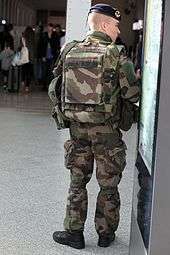
With France divesting itself of its colonies, on 1 December 1958 the title of Troupes d' Outre-Mer (Overseas Troops) replaced that of Troupes Coloniales. Finally, on 4 May 1961, the historic designation of "Troupes de marine" was readopted, this time for all the Troupes Coloniales. They became a major component in France's Forces d'Intervention. On July 1963 the 9th Marine Infantry Brigade (9e Brigade d'Infanterie de Marine) (9e BIMa) of the Troupes de marine was formed as the first French Force d'Intervention. It was named after and carried the insignia of the 9th Colonial Infantry Division (9e DIC) that had performed a successful amphibious assault on Elba in World War II. The Troupes de marine remaining overseas became part of the Forces d'outre mer. In 1964 the Force d'Intervention was expanded by adding two airborne brigades and one motorized brigade and formed into the 11th Division d'Intervention, which became the 11th Parachute Division in 1971. The Troupes de marine were removed from this division in 1976 to form a separate intervention force, and the 9e Brigade d'Infanterie de Marine was expanded on 1 January 1976 to form the 9e Division d'Infanterie de Marine (9e DIMa). This division was the amphibious component of the Force d'Intervention, which was renamed the Force d'Action Rapide (FAR) in 1983.
Because of their overseas heritage and their use in the Force d'Intervention, the Troupes de marine were mostly volunteer regulars, as in France, draftees are legally exempt from overseas duty. The conversion of the French Army into a smaller professional force led to the French Army's decision to make the brigade its largest formation and the 9e Division d'Infanterie de Marine was reduced in size on 1 July 1999 and became the 9th Light Armoured Marine Brigade (9e Brigade Légère Blindée de Marine).
The Troupes de marine are one of the "armes" (corps) of the French Army, which includes specialties associated with other corps (artillery, cavalry, signals) but with overseas deployment as a specialisation.
Gallery
 Marsouin in full metropolitan dress, as worn until 1914.
Marsouin in full metropolitan dress, as worn until 1914. Officer and Marsouin (private) in colonial dress, late 19th century.
Officer and Marsouin (private) in colonial dress, late 19th century. Marine infantrymen in Tonkin, 1884.
Marine infantrymen in Tonkin, 1884. French Marines in Madagascar (1894–1895).
French Marines in Madagascar (1894–1895). French colonial soldier in Congo (1905)
French colonial soldier in Congo (1905)
Nicknames
Troupes de marine soldiers are known in French as marsouins ("Harbour porpoise"), allegedly because, like porpoises, they accompany ships without really being part of the crew.
Marine Gunners are known as bigors, a nickname whose origin is disputed. It could come from bigue dehors which was the order given for loading the guns on a ship. It could also come from bigorneau (winkle in English), either due to their toughness and unwillingness to desert their positions in combat or because their duties usually had them stuck on coastal rocks.
Composition
The Troupes de Marine include:
- Infanterie de Marine
- Infantry (infanterie de marine, abbreviation: -IMa)
- Light Cavalry (infanterie de Marine, abbreviation: -IMa, and -ICM), cavalry units of Troupes de Marine use the military ranks of infantry.
- Airborne (parachutistes d'infanterie de marine, abbreviation: -PIMa)
- Artillerie de Marine
- Artillery (artillerie de marine, abbreviation: -AMa)
Uniform
The modern Troupes de marine uniform is the same as for other units of the French Army (light beige, plain green or woodland or desert camouflage according to circumstances). Distinctive features are a gold metal fouled anchor badge on a dark blue beret (Marine paratroopers wear red berets and their badge is a composite of the gold metal anchor and the silver wing of airborne units). This is worn either on the beret or embroidered on the front of the kepi.
The modern full dress includes a dark blue kepi, yellow fringed epaulettes (official colour name is daffodil) and a navy blue cravat (scarf worn around the neck). A red waist sash is also sometimes worn by certain units with a history of colonial service in Africa and Indo-China.
Historically the uniform consisted of a blue kepi with red piping, double breasted navy blue tunic, lighter blue trousers, and yellow epaulettes. Worn by all ranks until 1914, the blue uniform was reissued for regular personnel in 1930 and is still worn by bandsmen. This traditional uniform gave the nickname of "the Blue Division" to the Troupes de marine units involved in the 1870 Franco-Prussian War. The pith helmet was worn overseas during the colonial period, with blue, khaki or white uniforms according to circumstances. Until the early 1960s a dark blue calot (forage cap) with red piping and anchor badge was the usual distinction of the Troupes de marine.
gallery
 Beret of the French Army's Troupes de marine infantry.
Beret of the French Army's Troupes de marine infantry. The distinctive badge with an anchor and the yellow epaulettes of the Troupes de marine. This uniform is only used for parades.
The distinctive badge with an anchor and the yellow epaulettes of the Troupes de marine. This uniform is only used for parades. Calot " of tradition".
Calot " of tradition". Shoulder Patch of the cavalry,of paratroopers and marines.
Shoulder Patch of the cavalry,of paratroopers and marines.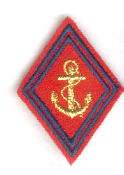 Shoulder patch of the marine artillery.
Shoulder patch of the marine artillery.- Képi T.D.M caporal chief or sergeant.
Kepi and traditional epaulettes
The modern kepi is presented to new recruits in a solemn ceremony. It is worn by officers and non-commissioned officers when another headdress is not prescribed. The kepi is entirely dark blue - a very dark blue, often mistaken for black - with a red (privates and corporals) or gold (non-commissioned officers and officers) trimming. All kepis display the anchor insignia of the Marines. When not being worn the kepi is expected to be positioned so that the anchor is always visible.
The "traditional" epaulettes used by the TdM are gold for officers and NCOs and wool of "daffodil" yellow for other ranks. This colour and pattern is derived from the historic epaulettes of the Metropolitan light infantry.
Golden Spurs
The officers of marine "mounted" units (that is to say those formerly using horses, or currently armored vehicles) have the privilege of wearing gold spurs for certain occasions. This differs from the usual French cavalry practice of wearing silver spurs. Tradition has it that Queen Victoria of England requested this distinction for the marine troops from Emperor Napoleon III to honor the branch after the Battle of Balaclava in the Crimea (1854) where marine infantry saved British troops from destruction.

Sword
The officers and senior non commissioned-officer can wear, in special circumstances, a sword as a part of their dress uniform. This sword has a straight-edge blade, in contrast to other Army Corps' curved sabers. Since the second world war, the sword is very rarely used.
Beret
The armored, artillery and infantry regiments of the Marines wear dark blue berets with golden anchor insignia. The parachute regiments of the Marines (1 RPIMa, 2 RPIMa, 3 RPIMa, 8 RPIMa) wear a red beret with anchor and wing insignia.
Inherited from the British Parachute Regiment, the red beret was awarded to French paratroopers by King George VI. It was worn officially for the first time in the French army by the 2nd and 3e RCPs at a parade on 11 November 1944. After undergoing a few modifications, the crimson beret became the standard headdress for all French 'Metropolitan' and 'Marine' airborne troops in 1957, except for the Foreign Legion paratroops who retained the green beret of the Legion.
 Beret badge worn by the paratroops of the French colonial troops.(Obsolete)
Beret badge worn by the paratroops of the French colonial troops.(Obsolete) Current Beret badge worn by the Marine paratroops
Current Beret badge worn by the Marine paratroops.jpg) red beret (Amaranth) of marine paratroops (France).
red beret (Amaranth) of marine paratroops (France).- Marine parachutists in Rwanda.
- The companies of the 1st Parachute Regiment of Marine Infantry, in 2008 in Bayonne.
- Color Guard of the 1st Parachute Regiment of Marine Infantry November 11, 2008, in Bayonne.
 Jumping uniform and equipment worn by parachutists of the Marine paratroops.
Jumping uniform and equipment worn by parachutists of the Marine paratroops.- Ceremonial parade of companies of the 1st Parachute Regiment of Marine Infantry, in 2008 at Bayonne.
- Change of command of Colonel of the 1st Parachute Regiment of Marine Infantry, in 2008 at Bayonne.
 French military parachutist badge
French military parachutist badge
Marsouins, Bigors and Biffins
The nickname used by Marsouins and Bigors for the other branches of the French Army is biffins (slang for ragmen). The name originated in the nineteenth century when sailors of the Fleet and Marine Infantry and Artillerymen, proud of their own smart appearance, accused the soldiers of the Army of being slovenly by comparison. The Legion is excused this nickname, probably reflecting a special relation between Marsouins and legionnaires.
Traditions
The Feast of the Marines: in the name of God, long live the colonials. This expression is believed to have originated with the famous missionary Charles de Foucauld who, when rescued by colonial troops, exclaimed "In the name of God, the great colonials!". Annual ceremonies celebrating the marine troops take place on August 31 and September 1 – the anniversary of the Blue Division. On August 31 detachments of all marine units parade at Fréjus where the Museum of Marine Troops is located. On 1 September veterans hold a ceremony at Bazeilles in Ardennes.
The anchor of gold
As a naval symbol since ancient times, the anchor appeared on the uniforms of French sailors from the late eighteenth century. The Marine Infantry and Artillery troops adopted this insignia at the same time and it remains the modern symbol of the Troupes de marine.
- 1772: a royal ordinance provides for the port anchor badge on the uniforms of the French Royal Navy, including the Marine Regiment.
- 1900: the anchor is carried by the Colonial Infantry with their transfer to the Army.
- 1916: the Colonial Troops adopt the badge of an anchor over a flaming grenade (the latter being a traditional distinction of elite troops).
- 1919: All officers of the Colonial Troops adopt a gold anchor on their kepis.
- 1920: an anchor entwined with a cable becomes the common badge of Colonial Troops.
- 1933: Colonial Artillery gunners no longer wear the grenade insignia.
- 1935: the anchor insignia appears alone on the armbands worn by Staff officers of the Colonial Troops.
- 1939: the anchor no longer to be worn with an intwined cable.
- 1945: the anchor officially sanctioned to be worn on all the attributes (including headgear and uniforms) of the Colonial Troops.
- 1953: approval of a "traditional" anchor design for the CT.
- 1962: introduction of the TDM beret, regulated by the Corps, with the gold anchor badge as the DUI (Distinctive unit insignia).
- 1985: "traditional" anchor now permitted to be worn on pennants and guidons.
Location
The particular role of this branch of the French Army is to consolidate various specialties: infantry, artillery, cavalry (armored), parachuting and transmission. These specialties, which are consolidated in the Troupes de marine branch, form separate arms in the rest of the Army.
Current units
- Metropolitan France:
- Régiment de Marche du Tchad (RMT) in Meyenheim[5] (mechanized infantry)
- Régiment d'infanterie-chars de marine in Poitiers (light armoured)
- 1er Régiment de Parachutistes d'Infanterie de Marine (1er RPIMA) in Bayonne (airborne special forces)
- 3e Régiment de Parachutistes d'Infanterie de Marine (3e RPIMa) in Carcassonne (airborne infantry)
- 8e Régiment de Parachutistes d'Infanterie de Marine (8e RPIMa) in Castres (airborne infantry)
- 1er Régiment d'Infanterie de Marine (1er RIMa) in Angoulême (light armoured)
- 2e Régiment d'Infanterie de Marine (2e RIMa) in Le Mans (infantry)
- 3e Régiment d'Infanterie de Marine (3e RIMa) in Vannes (infantry)
- 21e Régiment d'Infanterie de Marine (21e RIMa) in Fréjus (infantry)
- 1er Régiment d'Artillerie de Marine (1er RAMa) in Châlons-en-Champagne (artillery)
- 3e Régiment d'Artillerie de Marine (3e RAMa) in Canjuers (artillery)
- 11e Régiment d'Artillerie de Marine (11e RAMa) in Saint-Aubin-du-Cormier (artillery)
- Overseas:
- 2e Régiment de Parachutistes d'Infanterie de Marine (2e RPIMa) in Pierrefonds (Réunion) (airborne infantry)
- 5e Régiment interarmes d'outre-mer (5e RIAOM) in Djibouti
- 6e Bataillon d'Infanterie de Marine (6e BIMa) in Libreville (Gabon) (infantry)
- 9e Régiment d'Infanterie de Marine (9e RIMa) in Cayenne (French Guiana) (infantry)
- Détachement Terre Antilles/33e RIMa (33e RIMa) in Fort-de-France (Martinique) (infantry)
- Régiment d'Infanterie de Marine du Pacifique – Nouvelle Calédonie (RIMaP-NC) in Nouméa New Caledonia (infantry)
- Détachement Terre de Polynésie/Rimap-P (RIMaP-P) in Papeete (infantry)
- Traditions only
- These units had been disbanded, but their traditions had been trusted to other units.
- 4e régiment d'infanterie de Marine : bataillon du service militaire adapté de Mayotte.
- 11e régiment d'infanterie de Marine : régiment du service militaire adapté de Polynésie française.
- 67e régiment d'infanterie de Marine : Groupement de transit et d'administration du personnel isolé.
- 5e régiment d'infanterie de Marine : 4e régiment du service militaire adapté in Guyane.
- 7e régiment d'artillerie de Marine : 3e régiment du service militaire adapté in La Réunion.
- 10e régiment d'artillerie de Marine : 2e régiment du service militaire adapté in Guadeloupe.
- 41e régiment d'artillerie de Marine : régiment du service militaire adapté de Nouvelle-Calédonie.
- Color Guard of the 22nd battalion of marines, November 11, 2008, in Nantes.
 21st Regiment of marine infantry, Bastille Day 2008 military parade on the Champs-Élysées, Paris.
21st Regiment of marine infantry, Bastille Day 2008 military parade on the Champs-Élysées, Paris. Parade of Companies of 2nd for the Navy change of command.
Parade of Companies of 2nd for the Navy change of command. Military marine troops French Task Force, August 13, 2009, Korrigan (French forces in Afghanistan).
Military marine troops French Task Force, August 13, 2009, Korrigan (French forces in Afghanistan).- Clarion marine troops in Kuwait after the Desert Storm.
 Ceremony of creation of battle group Richelieu, 2nd Regiment of Marines, before departure to Afghanistan.
Ceremony of creation of battle group Richelieu, 2nd Regiment of Marines, before departure to Afghanistan.- The dissolution ceremony at Le Mans July 7, 2011, the battalion / battle group Richelieu of the 2nd Regiment of Marines after return from Afghanistan.
- Following the dissolution of the battalion.
- Following the dissolution of the battalion.
- Following the dissolution of the battalion.
Anthem
(traditional)
This song is sung at a brisk pace to marching music
- In battle or storm,
- The chorus of male songs, (repeat)
- Our soul always ready to danger,
- Brave and lightning guns.
- Men of iron that nothing weary
- We look death in the face,
- In the roaring storm or rough fight. Forward!
- To make a soldier of Marine
- You need in the chest
- The heart of a sailor and that of a soldier.
- Often in the torrid zone,
- The tooth tiger or lion
- Fever or ball homicide
- Just decimate our battalions.
- So to the motherland,
- We see, contorted with agony,
- In a supreme effort to turn our front. Forward!
- And we regret unanimous
- Dear France, O sublime country!
- This is for you to have one life to give.
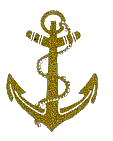
- Be proud soldier in the Navy,
- Love thy victory bugles
- And your face illuminated by burnished,
- The brilliance of great deeds.
- From the Bosphorus to Martinique,
- From Senegal to the Pacific
- We see your flag colors shine. Forward!
- The glory took you under his wing,
- For the honor always faithful,
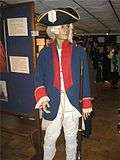
- You die in battle or you come back victorious.
- In every battle in the Crimea,
- We too have taken part
- De Malakoff under fire,
- We were climbing the walls.
- At the sight of our uniforms,
- That the fire or sword deforms,
- The enemy turned pale, stepped back many times. Forward!
- And on our foreheads that shines,
- We can see the triple crown
- The laurels of Podor, of Inkerman and Alma.
- When Prussia inundating France,
- About Us unleashed its fury,
- At his balls as his spears
- We have opposed our hearts.
- And when the battle roared,
- Our forehead, wounded by shrapnel,
- Bloody, but untamed, defied the winners. Forward!
- A Bazeilles The Cluze and Neuville,
- When fighting against one hundred thousand,
- The success betrays us but we kept the honor.
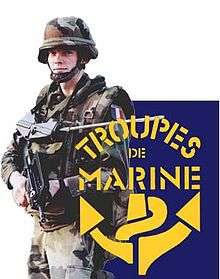
- Constantly ready for any fight;
- Valiant soldiers of our major ports,
- No nothing can kill you
- Who do you count your dead point
- You reduce Chinese, Kanaka,
- In Madagascar you, Annam and Tonkin. Forward!
- Also under the sky its dome
- Joined still halo
- Son-Tay and Nouméa, Tamatave and Beijing
- A day will come, dear hope,
- Where the ardent call of bugles,
- Will rise to our France
- Avengers ... and we will.
- So for us, oh what a feast!
- We will give younger sisters,
- For the victories of Jena, Auerstadt, Stettin. Forward!
- Yes we love the holy wars
- For the blood of heroes, our fathers,
- In our blood on fire, do not flow in vain
Values of the Marine Troops
Formed initially to be deployed for service on France's overseas territories to maintain French interests, the marine troops have acquired a culture of openness. In addition, foreign missions have required the weapon it covers areas of varied specialties (combat infantry and armor, fire support, communications ...) the exercise of which, today, reinforces a long history of professionalization.
Transcending the concept of mastering military equipment and technologies, the marine troops to unite around a single symbol, the traditional golden anchor, that for those who serve marks a unique style whose main features are:
- A brotherhood of gun mindset maintained by simple and warm human relationships between comrades in arms;
- An ability to adapt to the most unusual situations, a true lifestyle product of history and operational experience repeated;
- A "military humanism", perpetuating culture of others including the ability to make contacts with the most diverse populations and to gain their trust.
These high values of identity give meaning to the commitment of the Marsouin and Bigord and always based natural vocation of the marine troops serving both in the French overseas territories and abroad.
See also
| Wikimedia Commons has media related to Troupes de marine. |
- Fusiliers Marins
- Marine corps
- Tirailleur
- French colonial flags
- French colonial empire
- List of French possessions and colonies
Sources
- Les Troupes de Marine 1622–1984, Paris: Charles-Lavauzelle, 1991, ISBN 2-7025-0316-0 or ISBN 978-2-7025-0316-4.
- Serge Saint-Michel & Rene Le Honzec, Les Batisseurs d'empire Histoire Troupes de marine Tome II 1871–1931
- CEHD (Centre d'Etudes d'Histoire de la Défense), Les troupes de Marine dans l’armée de Terre. Un siècle d’histoire (1900–2000), Paris, Lavauzelle, 2001, 444 p., ISBN 2-7025-0492-2
- Historique du 16e régiment d'infanterie de marine. Année 1900, Paris, H. Charles-Lavauzelle, 1903.
- Louis Beausza, La formation de l'armee coloniale, Paris, L. Fournier et cie., 1939.
- Marcel Vigneras, Rearming the French, Office of the Chief of Military History, Dept. of the Army, 1957
- John C. Cornelius, Richard J. Sommers, Michael Winey, The Military Forces of France, Washington, GPO, 1977.
- Anthony Clayton, France, Soldiers and Africa, London; Washington: Brassey's Defence Publishers, 1988, ISBN 0-08-034748-7 or ISBN 978-0-08-034748-6.
- Comité national des traditions des troupes de marine, De Bizerte à Sarajevo : les troupes de marine dans les opérations extérieures de 1961 à 1994, Paris:C. Lavauzelle, 1995, ISBN 2-7025-0380-2 or ISBN 978-2-7025-0380-5.
References
- ↑ http://www.stripes.com/news/french-military-effort-in-afghanistan-earning-respect-of-u-s-troops-1.96007
- ↑ "French Marine Is Killed in a Clash Linked to the Taliban". The New York Times. 5 March 2006.
- ↑ "Fusiliers marins et commandos marine".
- ↑ Lavauzelle, Charles. Les Troupes de Marine 1622-1984. pp. 346 & 364. ISBN 978-2-7025-0316-4.
- ↑ "Unités composant les troupes de marine". french government. Retrieved 2012-02-17.
External links
- Official website
- Unofficial site (managed by the national federation of veterans of oversea and marine troops)
- (French) Centre de ressources sur les TDM
- (French) Musée des troupes de marine de Fréjus
- (French) Les troupes coloniales dans la Grande Guerre
